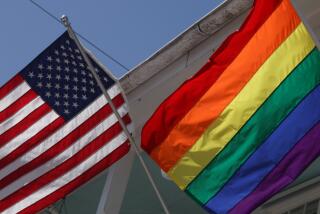Statistics and Science Can Be Twisted to Suit Debate : Research: Groups frequently distort or present inaccurate scientific information to the public about gay men and women to boost their arguments.
Statistics and scientific claims frequently are used in the gay rights debate to bolster one point or another. And frequently, experts say, the information is misrepresented, inaccurate or at odds with mainstream scientific thought. Some examples:
* Concerned Women for America, a conservative women’s organization, ran a national newspaper advertisement in April supporting the ban on gay men and lesbians in the military. The ad said “a recent study in the Annals of Internal Medicine” showed “homosexual behavior to be promiscuous, compulsive and uncontrollable;” that the “typical homosexual” has at least 68 sex partners each year and that homosexuals have “alarmingly high rates of AIDS” and other ailments.
Dr. Robert H. Fletcher, editor of the journal, said the advertisement distorted the study “in a huge way.” Published in 1984, the study was not based on a random sampling of the gay population, but was a survey of people with AIDS during the early stages of the epidemic. “This was a very, very biased sample of homosexuals,” Fletcher said. Compulsiveness and uncontrollable behavior were never discussed in the article. And the sex partner statistics were drawn from data on only 50 gay or bisexual men whose promiscuity was considered a major factor in contracting the AIDS virus.
A spokeswoman for Concerned Women defended the ad: “We do not feel the material was misapplied.”
* To counter perceptions that gays are a small minority, activists have long said gay men and lesbians make up 10% of the population. The figure is taken from a 1948 Kinsey study that concluded that 10% of white males were predominantly homosexual for at least three years between the ages of 16 and 55. But the survey was not based on a scientifically random population sample and subsequent studies cite significantly lower figures.
“It was one of those things that gathered its own reality,” said sociologist Pepper Schwartz, president of the Society for the Scientific Study of Sex, the largest sex research organization in the nation. “It got a reality it didn’t deserve.”
* Anti-gay rights material often claims that child molestation figures show the propensity for pedophilia is far higher among homosexuals than heterosexuals.
“That’s unfounded. There’s no evidence of that,” said A. Nicholas Groth, a clinical psychologist who has worked with more than 3,000 sex offenders and co-authored the 1978 book “Sexual Assault of Children and Adolescents.”
Groth said it is wrong to assume that a man who engages in sex with a boy is homosexual. In his research with child molesters, Groth said he found that men who molested boys were “often homophobic” and either did not have adult sexual relationships or had them primarily with women.
* Some gay rights foes describe homosexuality as a behavior disorder that can be treated and reversed with “reparative therapy.”
The American Psychiatric Assn.--which dropped homosexuality from its official manual of mental disorders in 1973--says “homosexuality per se implies no impairment in judgment, stability, reliability, or general social or vocational capabilities.” In a 1993 fact sheet, the association says “there is no evidence that any treatment can change a homosexual person’s deep-seated sexual feelings for others of the same sex.”







